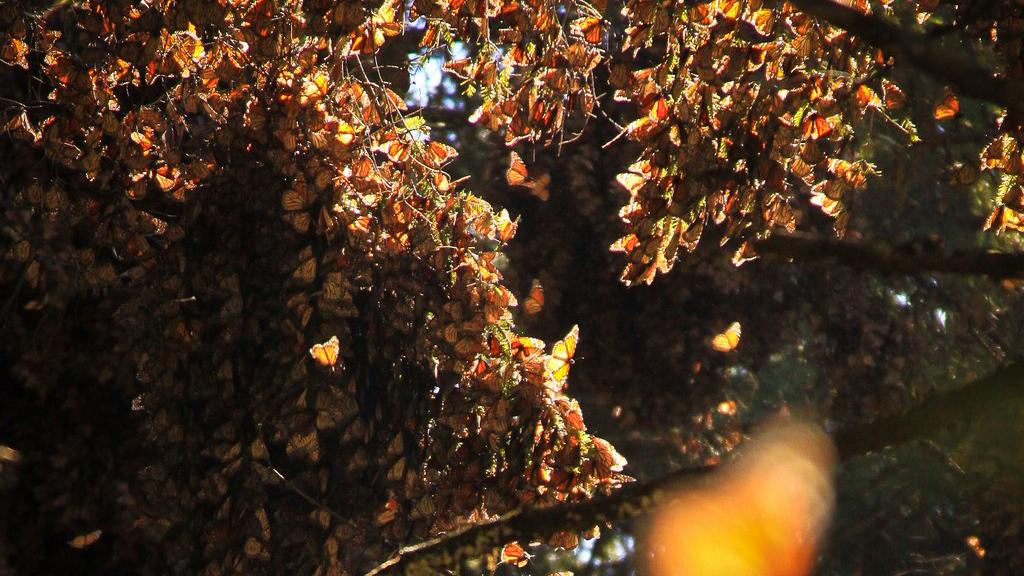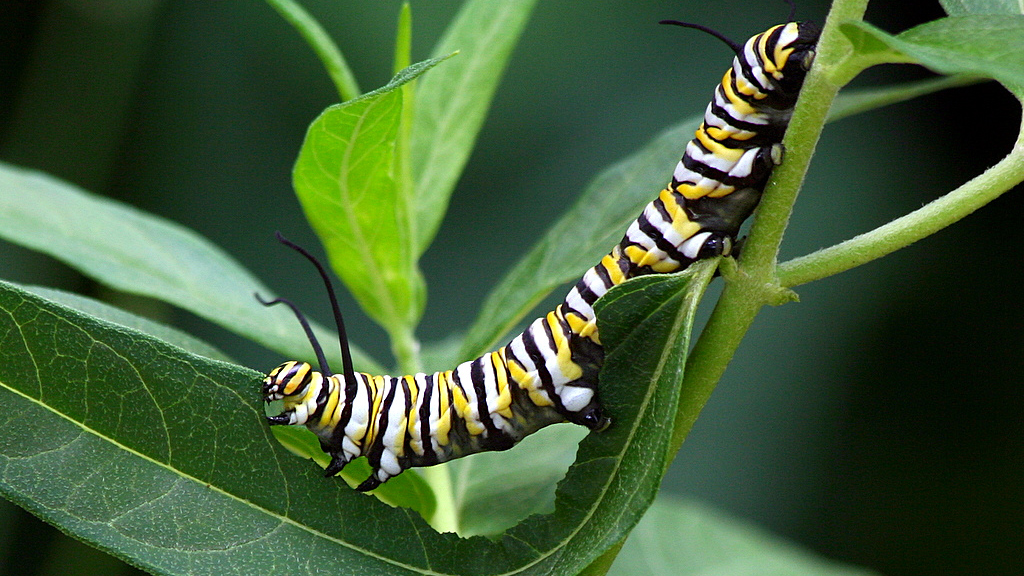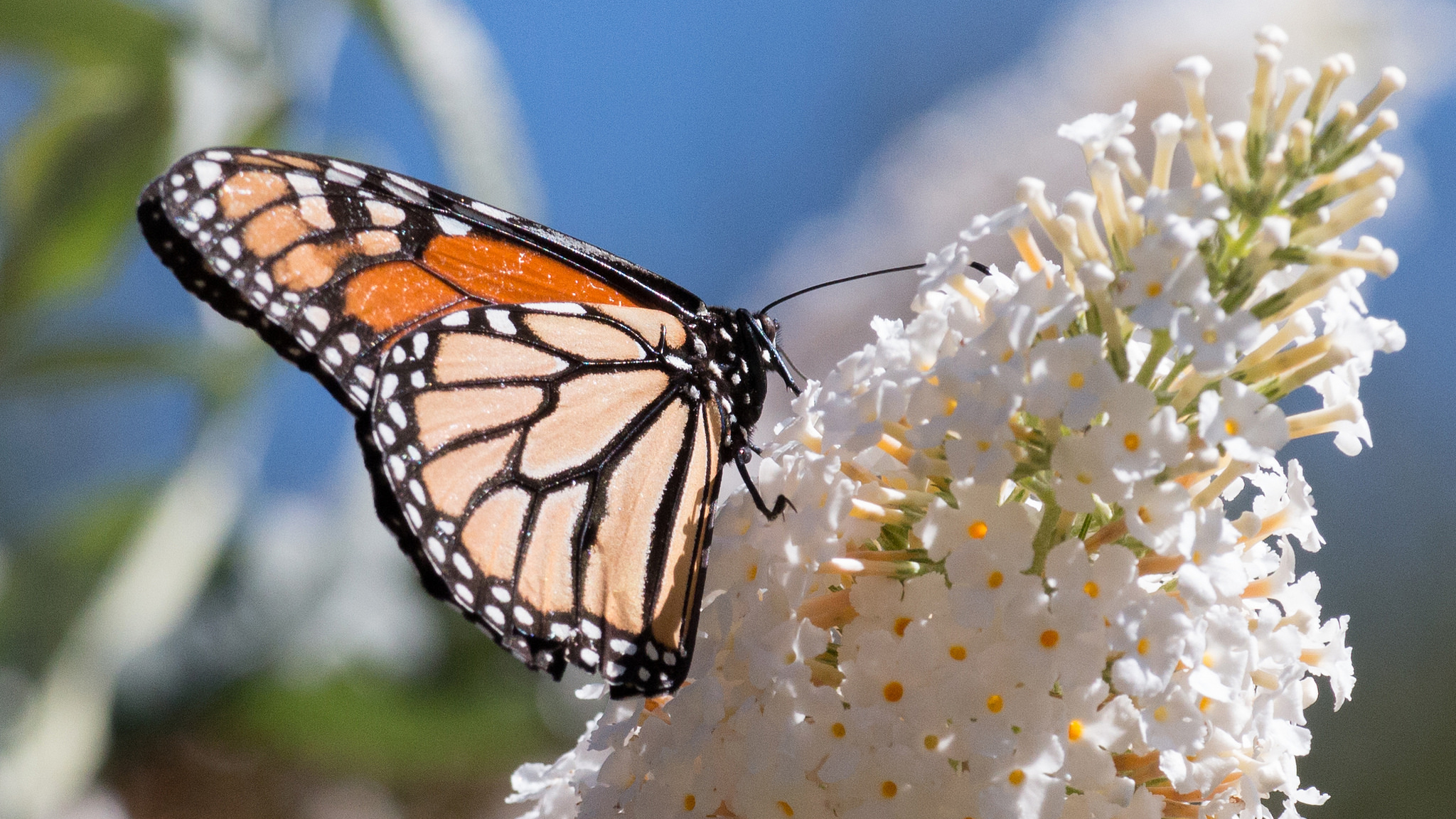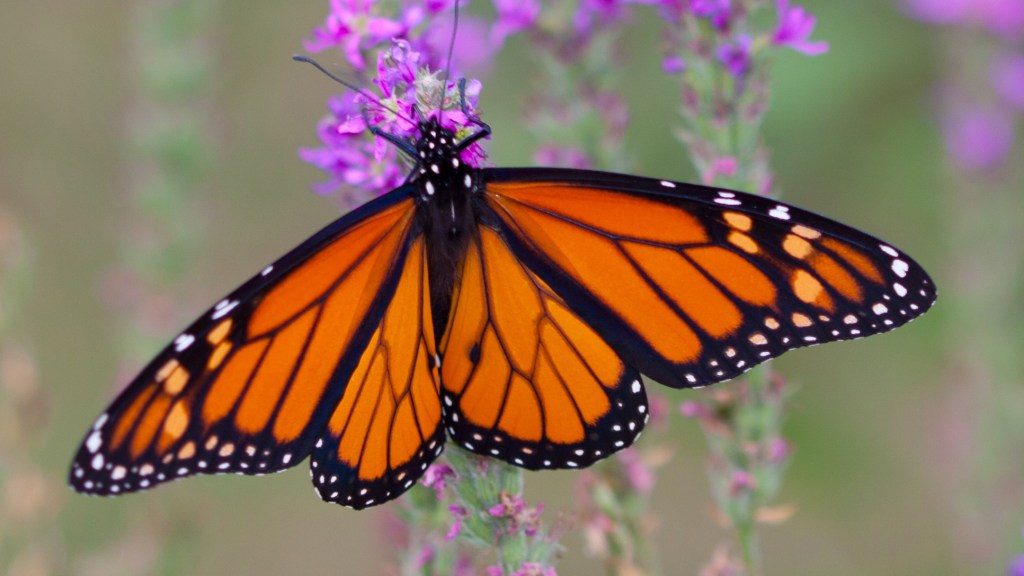Twenty years ago, monarch butterflies occupied so much area in Mexico during the winter you could see it from space. It totaled about 20 hectares, or almost 50 acres, with millions if not billions of butterflies clinging to trunks and branches of trees.
Today, that area is around 4 hectares. The previous year had 1.1 hectares, says Brice Semmens, Assistant Professor at the Scripps Institution of Oceanography at the University of California San Diego.
Semmens was the lead author on “Quasi-extinction risk and population targets for the Eastern, migratory population of monarch butterflies” published recently in the journal Scientific Reports. It is one paper in a long line of sobering butterfly news.
The monarch likely won’t ever become extinct, Semmens says. Small populations live scattered throughout Mexico, the central U.S. and Canada, and some were moved to places as far away as Hawaii and New Zealand.
But the massive eastern migrations between central Mexico and Canada that have inspired people for centuries could be lost.
Semmens’ paper used expert opinion to determine how little occupied winter habitat in Mexico would be needed to sustain a viable migratory population – and at what point it simply may not bounce back.

The authors used estimates of extinction rates with various overwintering sizes, and conclude monarchs need about 6 hectares, or about 15 acres, to cut the risk in half.
But in order to understand how to boost overwintering numbers, people must first understand what hazards the eastern monarch faces.
Semmens and University of Minnesota monarch expert Karen Oberhauser recently walked the Cool Green Science Blog through each threat, as well as some possible solutions.
Habitat Loss
This one isn’t a surprise. Many North American species face some kind of habitat loss, but the eastern monarch is struggling throughout its three-country migration route.
In the winter, the butterflies need insulated cover in the form of dense Mexican forests. While the area is protected by the Mexican government, its edges are still being eaten away by illegal logging.
But also critical are the other migratory stages. In each one between Mexico, the Midwestern U.S. and southern Canada, monarchs need milkweed. They can only reproduce with the flowering plant.

And since each annual migration might create four or even five generations of monarchs, less milkweed directly correlates to fewer butterflies, according to Oberhauser. Unfortunately, the plant has been effectively removed by the millions from most agricultural fields and neighboring areas throughout the Midwest.
“The hopeful thing is that monarchs can really use habitat in a lot of different places,” she says. “It’s not like we’re talking about spotted owls that need hundreds of acres of untouched forest. They can find a milkweed plant growing in a crack in a sidewalk.”
Climate Change
Monarchs suffer under drought and severe storms, two weather events becoming more common with climate change.
“If you imagine an EKG or something, a line going up and down, insect populations in general are very erratic,” says Oberhauser. “They are very driven by weather conditions and what we call stochastic variation, variation we don’t have control over and can’t predict.”
The biggest risk with storms is freezing to death. Butterflies can survive temperatures down to about 17 degrees Fahrenheit if the cold is dry. But temperatures of about 25F with rain often mean death. A single storm in 2002, for example, killed almost 80 percent of the monarch population.
“That year the population was pretty high,” Oberhauser says. “But two years ago when the population was down to under 1 hectare, if we lost 80 percent, the number might have been too small to be a viable population.”
Pesticides and Herbicides
Milkweed used to grow scattered throughout corn and soybean crops across the Midwest. But more efficient agriculture practices and products such as Roundup have nearly eliminated monarch habitat, according to Semmens.
“It’s not that the use changed, it’s still agriculture, but the weed control changed and made it hard for monarchs,” he says.

Monarchs are also suffering from something called neonicotinoids, a relatively new class of insecticides with poison growing in all tissues of the plant. They make the plant itself poisonous to insects.
So what can you do?
Leaders of all three North American countries have decided monarchs are a priority. As a result, the U.S. government, through the departments of the Interior and Agriculture, are creating strategic goals for increasing habitat.
The U.S. needs about 1.5 billion new stems of milkweed, or about 500 million new plants, to help reach the 6 hectare overwintering goal, says Wayne Thogmartin, a research ecologist with the USGS.
“It will require participation from all sectors of society,” he says. “If we try and rely on any single sector we won’t reach our goals. If we say this is an agricultural problem and we need to rely on them to solve it, it won’t get solved. If we say we will achieve this by having everyone plant milkweed in their backyard, it won’t solve the problem. We need everyone’s participation.”
But each person can make a difference.
Here are a few places the researchers suggest to start:
- Create habitat in your backyard, school or office. If you can, remove some grass and put in a garden. Each new plant makes a difference.
- Sign up for monarch citizen science projects and collect data for researchers. For more information, go to monarchjointventure.org.
- Ask before you buy. If you want to plant a pollinator-friendly garden, ask to be sure the seeds or plants weren’t treated with neonicotinoids.
- Talk to your friends, neighbors and relatives.
- Donate to organizations working for conservation of habitat including The Nature Conservancy, the Monarch Joint Venture and the Monarch Butterfly Fund.




We have a home in Ketchum ID. Can I plant milk weed seed there? Very short growing season. What species of milk weed? Thank you .
In Hastings Minnesota we are starting what we call pollinator patches. We hope to put in 3 this spring. Each is about 5 ft. by 10 ft. We may do more if we get enough volunteers to help. There is vacant city park land so we are working with the city to locate the patches.
Last summer I bought one Blazing Star plant and by early last fall early it was blooming. I saw 3 monarchs on it sometimes. Then late in the fall after the monarchs were gone the rabbits ate it. A planting that had been done by FRIENDS OF THE MISSISSIPPI last spring had about 30 monarchs on the blazing star plants in late summer. There were other species of plants there also.
Also the tiger swallowtail butterfly is often seen around the area but I don’t have any information about its preferred habitat. Can someone shed info. on this striking critter.
We used to have butterfly bushes planted in Long Beach, New York for the migrating monarchs but after several storms (pre superstorm Sandy) they died and were never replanted. Would this help the Monarchs if we replanted this and/ or milkweed or have the migratory patterns changed?
As a biologist in Africa I observed the African monarch feeding on stapeliads (succulent members of the milkweed family). I have been growing stapeliads in California for decades and have never seen the closely related American monarchs feeding on them. Does anyone have an explanation for this?
This article was very apropos for me– I just finished reading Barbara Kingsolver’s FLIGHT BEHAVIOR, a fictionalized delving into the Monarch dilemma as it pertained to an isolated community in the Southern Appalachians.
Where is a reliable place to get milkweed seeds from?
In central Pennsylvania, the Susquehanna River Valley Visitors Bureau is partnering for a new promotion – “Roll Out the Monarch Red Carpet” – to have native milkweed gardens planted at businesses, in communities and in homes to support the migration path of the Monarchs. The Susquehanna Greenway Partnership is working with Weis Markets to have milkweed planted along the banks of the river. For more information go to http://www.monarchredcarpet.org/ .
Is there some kind of advocacy we can also do, relating to monarch-friendly agriculture policy? It’s not like the monarchs have agribusiness lobbyists to speak for them.
Where can I find milkweed plants? I have not seen it in any big box stores or nurseries!
Thanks
I live in Sequim, Washington and found Monarch butterflies in my apple tree last week clinging to a blossom. Knowing that it needs a specific milkweed in order to lay eggs I contacted my local Univ. of Washington Extension office in Port Angeles, all my local plant dealers and discovered not one knew that we not only had Monarchs in our area but had no clue what milkweed they might need. I contacted our local newspaper, Peninsula Daily News, requesting they write an article asking our community to get involved and received nothing. It’s discouraging, to realize how important it is to support the Monarchs in their desperate need to survive and realize my town isn’t willing to stand up to the plate.
I hope you receive more encouraging stories from others who care, gayleen Hays, Sequim, Wa.
You said to plant a garden which we have, but do they only eat milkweed. What type of milkweed do they need. Can they eat all types?
Asclepias incarnata (swamp milkweed,) the preferred type of milkweed, is difficult to find in local nurseries, and difficult to grow from seed. I live on the coastal plain of Maryland (Eastern Shore). I grow Asclepias tuberosa, but it does not seem to spread from year to year. Blossoms very short lived.
Any suggestions?
How do we get seeds for planting milkweed??? I would be more than happy to plant milkweed in my yard and encourage my neighbors to do the same!!
Walt H Wolf
I live on five acres of Post Oak and Red Oak, along with other species including grasses in the Texas Hill Country, but see few Monarchs. Wouldn’t planting Milkweed help? I would just scatter it around over the land. I have neighbors, some with hundreds of acres, used mainly for grazing cattle, sheep and goats, and most wouldn’t mind patches of Milkweed on their land. Of course, adequate food along the routes of migration is not the only problem, but it is one aspect in which those of us who love the natural world might be able to help. Can one purchase Milkweed seeds?
There are three of us science teachers at Don Estridge High Tech Middle School using the monarch butterfly in our lessons. I’m in charge of growing the milkweed and furnishing other plants for our Florida butterfly species. We’ve planted milkweed
In our nature preserve and in our school garden. We find our lessons on ecosystems and symbiotic relationships to be far more engaging using the butterflies. We’ll keep you posted, should you be interested in our efforts.